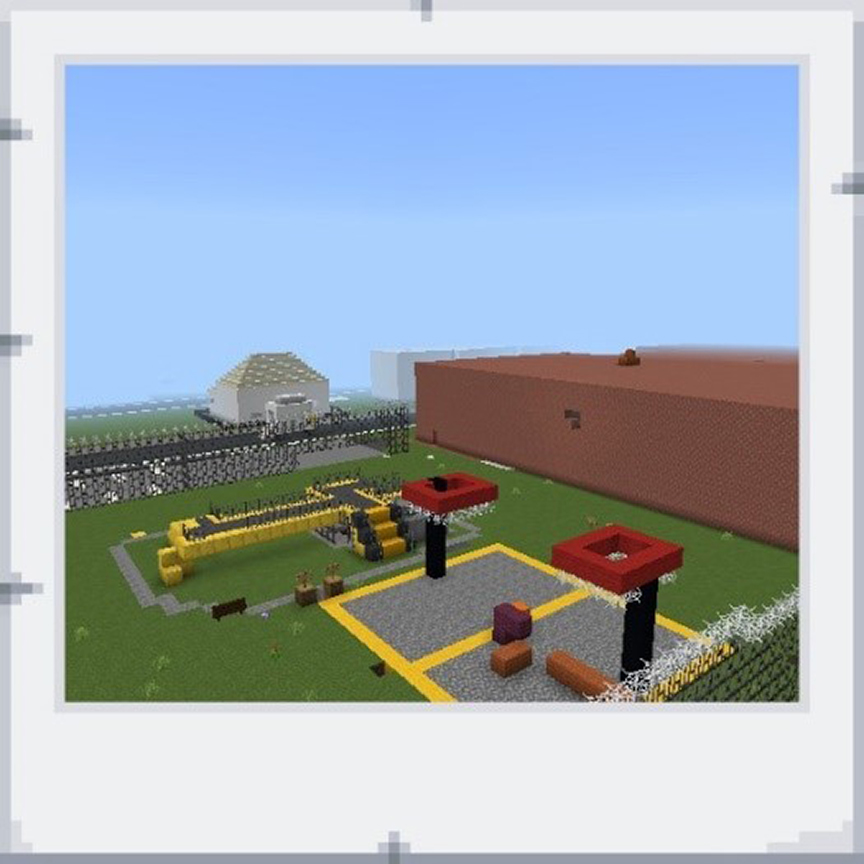
Explore our community in the past, present, and future using Minecraft.
A Grades 5/6 class had the opportunity to recreate their community in Minecraft. Learners were able to explore their community in detail, as well as their surroundings beyond their own home.
The learners began with a thorough community walk through their neighbourhood as part of a class field trip. They were partnered up and took part in a scavenger hunt where they recorded different types of buildings and building materials, and different features of the community, such as apartments, single-family homes, parks, stores, or restaurants. They recorded each of them and where they were found. The learners also recorded any notable features of the neighbourhood, such as hospitals, government offices, or fire stations.
On a second community walk, learners looked for specific landmarks in relation to the school. They determined the cardinal direction of each landmark and how many blocks away they were in relation to the school. The learners also had to note the roads and back alleys in a specified area and complete a detailed sketch using the information.
Once back in school, the learners accessed Google Maps and verified if their sketched map of the community was accurate. When all maps were verified, the learners were placed into Minecraft build teams. The different build teams were assigned different streets and different address ranges. There could be up to 30 learners building at the same time. The build teams had to coordinate with each other and decide where the first buildings would be placed. They also had to figure out scaling, realizing that one block in Minecraft was one metre cubed, but this would not translate to real-world scale. The teacher assisted the learners in finding their starting locations as needed. They could then reference Google Maps Street View to choose block types, colour, and any other details about the houses or buildings. As Minecraft is a collaborative environment, learners had to be aware and respectful of others’ creations as they planned their specific building tasks, and modified and adjusted their build plans as needed.
After the learners completed their building tasks, they were allowed to build their own homes in the community. Recreating their community in Minecraft was a long-term project that took months, and learners had the opportunity to contribute and do their part at varying times throughout the school week. They worked collaboratively, literally building on each other’s ideas and often offering feedback, suggestions, and planning for next steps within and across teams. Ongoing reflection and sharing regarding their collaborative work were a part of the process.
After the community build was complete, the learners engaged in some writing. First, they wrote a descriptive piece describing the current school community and what they had observed during the recreation in Minecraft. Next, drawing from their research on Indigenous communities (pre-European contact), the learners wrote a compare/contrast essay that described the differences and similarities between their current community and what life would have been like in the past. They had to draw attention specifically to use of the land, building styles and materials, and resource gathering. The learners also spent some time exploring Manito Ahbee Aki: The place where the Creator sits, in which learners can travel back in time to experience Anishinaabe culture, community, and teachings In Minecraft Education.
Finally, the teacher asked the learners to look towards the future. They envisioned what their community could look like 100 years from now. The teacher directed them to now use their imagination and creativity to build a future community above their current community (in the sky in Minecraft). Classroom discussions about environmental issues and sustainability prompted innovative design ideas and potential solutions for the future. This included solar panels, a futuristic waste disposal/recycle system, alternative transportation and housing, and so on.
To wrap up their study, the learners completed reflections both personally and in a Sharing Circle, considering their learning journey of exploring their community past, present, and future.
Microsoft Education. Manito Ahbee Aki: The place where the Creator sits. Microsoft Corporation, 2024.
Minecraft Education. What is Minecraft Education Edition? Microsoft Corporation, 2024.